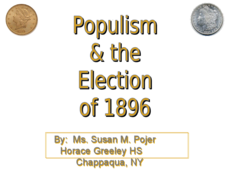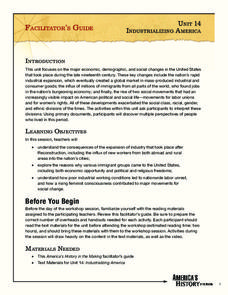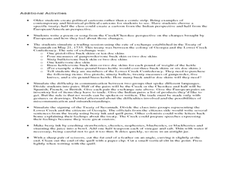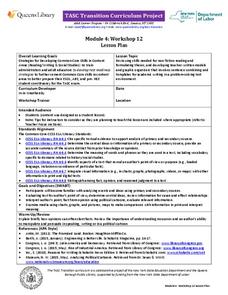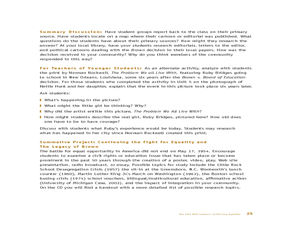Jamestown-Yorktown Foundation
Why Did Some Colonial Virginians Continue to Support the King?
Not all colonials supported the American Revolution. A resource from the American Revolution Museum at Yorktown ask young historians to investigate the reasons why some colonial Virginians were loyalist and continued to support King...
Curated OER
Causes of the American Revolution
Students access websites for background information and learn how to interpret political cartoons. They incorporate higher-order thinking skills to determine if the information presented in the cartoons is accurate, what the colonists...
Curated OER
Political Protest Through Art
Students examine how artists (painters or cartoonists) use artwork as a means of disseminating a political point of view in this lesson that uses primary source documents and examples of political cartoons.
Curated OER
Armenian Genocide
As your historians examine the beginnings of WWI, ensure they are familiar with the Armenian Genocide. This basic introductory lesson plan utilizes teacher-led discussion, map analysis, and a Socratic seminar. Not much detail is offered...
Curated OER
Editorial Cartoons: A Historical Example of Immigration Debates
Eleventh graders analyze political cartoons. For this American History lesson, 11th graders research the Chinese Exclusion Act and the current arguments about immigration to the United States. Students create a graphic organizer...
Curated OER
History: Declaration of Conscience Political Cartoons
Students examine political cartoons depicting opinions about Margaret Chase Smith's Declaration of conscience. After examining the cartoons, they create their own political cartoons about the speech. As an ongoing activity, students...
Curated OER
Cartoon Analysis Worksheet
In this cartoon analysis worksheet, students fill out the worksheet to assist in the analysis of cartoons. They consider symbols when determining the message of the cartoon.
Curated OER
Asian Americans and U.S.-Asia Relations
Students identify through research perceptions towards Asians widely held by the American public through the analysis of political cartoons from the 1940s and 1990s.
Curated OER
The Indian Subcontinent Since 1947: The Legacy of Independence
An exploration of Indian and Pakistani cultures and conflicts throughout the 20th - 21st centuries, this presentation features relevant political cartoons and poignant photos to illustrate the breadth of politics in India and Pakistan....
Curated OER
Populism & the Election of 1896
Populism and the rise and fall of the Populist Party are the topics of this presentation, which details the Presidential Election of 1896 and the role of silver. Detailing main points with clever political cartoons and informative maps,...
Annenberg Foundation
Industrializing America
Imagine an eight year old spindle boy working barefoot in a factory in the late 1800s. Scholars research the industrial period in American history in the 14th lesson of a 22-part series that explores the country's background. Groups...
Curated OER
Native Lands: Indians in Georgia-Shifting Ground Political Cartoon-Introduction
Students explore the relationship between the Creek, Cherokee, and European/American cultures prior to the American Revolution. Students do Internet research to identify and explain changes in these cultures, then create six panel...
Curated OER
Questions on Benjamin Franklin’s Cartoon
For this primary source analysis worksheet, students examine Benjamin Franklin's "Join or Die" political cartoon and then respond to 8 short answer questions based on their analysis of it.
Curated OER
1850s: Road to Secession
Detailing the political and social events leading up to the Civil War, this presentation provides students with maps, political cartoons, and photographs to put this time period into historical context. The Presidential Elections of...
EngageNY
TASC Transition Curriculum: Workshop 12
How can opinions slant facts? Workshop participants learn how to examine primary and secondary sources and identify the author's point of view. They also examine how visual art impacts the meaning and rhetoric of sources. Full of...
Curated OER
Revolutionary News Network
Seventh graders study events leading to, during and resulting from the American Revolution. They review elements of a political cartoon. They create and dramatize a scene from a Revolutionary War novel.
Curated OER
End of WWI: The Treaty of Versailles
After learning about the causes and closure of WWI, hand out this resource on that outlines the differences between Wilson's 14 Point Plan and the Treaty of Versailles. The class reads the information provided then analyzes two political...
Curated OER
The Past Half Century: Achieving Equality
Students analyze reactions to the Brown vs. Education decision of 1954. In this segregation instructional activity, student look at the actions that were taken in the education world as a result of the Brown decision. They watch a CD,...
Curated OER
Reconstruction (1865-1876)
Easily broken into pieces for several class sessions, this presentation is a great way to transition your class out of a Civil War unit and closer to the 20th century. Engaging photographs, including relevant maps and humorous political...
Curated OER
History of Modern Cuba
Set the context for the often-strained relationship between the US and Cuba with this informative and entertaining presentation. From political cartoons to photographs of Fidel Castro and Fulgencio Batista, as well as heartbreaking...
Carolina K-12
African Americans and the Vietnam War
No need to look any further. This resource has everything for a solid exploration of the role of African Americans in the Vietnam War. Class members read primary sources, including a Martin Luther King speech, political cartoons of the...
Carolina K-12
Revolutionary War Era Tick-Tack- Toe
So many fantastic activities on the American Revolution! From drawing political cartoons illustrating events of the Boston Massacre to writing a diary entry as a shopkeeper during the Boston Tea Party, your young historians will...
North Carolina Civic Education Consortium
The Nineteenth Amendment
Beginning with an exercise of favoritism to engage learners, progressing through image and primary source analysis of the Nineteenth Amendment and the Seneca Falls Declaration, and culminating in a look at a political cartoon called...
PBS
Mark Twain: Storyteller, Novelist, and Humorist
Scholars investigate the use of satire in Mark Twain's writing. Literary lovers research the Adventures of Huckleberry Finn and Tom Sawyer, political cartoons, and videos to see how Twain uses satire to make the stories more memorable....
Other popular searches
- Civics Political Cartoons
- Analyzing Political Cartoons
- Wwii Political Cartoons
- Drawing Political Cartoons
- Danish Political Cartoons
- 1990's Political Cartoons
- New Deal Political Cartoons
- History Political Cartoons
- Thomas Nast Political Cartoons
- Current Political Cartoons
- Civil War Political Cartoons
- Analysis of Political Cartoons











